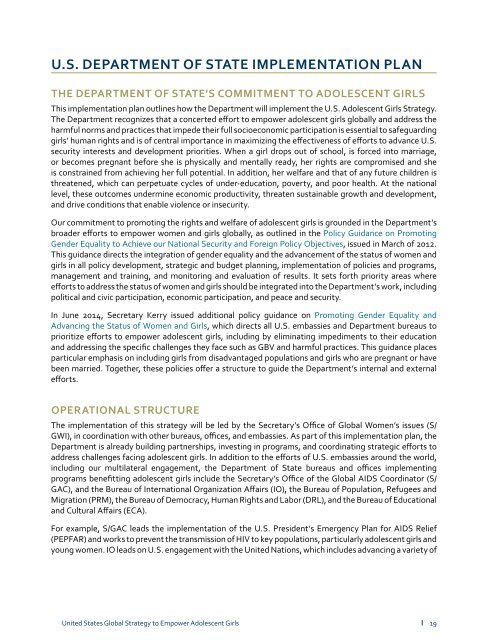GLOBAL STRATEGY TO EMPOWER ADOLESCENT GIRLS
ZNFdO
ZNFdO
Create successful ePaper yourself
Turn your PDF publications into a flip-book with our unique Google optimized e-Paper software.
U.S. DEPARTMENT OF STATE IMPLEMENTATION PLAN<br />
THE DEPARTMENT OF STATE’S COMMITMENT <strong>TO</strong> <strong>ADOLESCENT</strong> <strong>GIRLS</strong><br />
This implementation plan outlines how the Department will implement the U.S. Adolescent Girls Strategy.<br />
The Department recognizes that a concerted effort to empower adolescent girls globally and address the<br />
harmful norms and practices that impede their full socioeconomic participation is essential to safeguarding<br />
girls’ human rights and is of central importance in maximizing the effectiveness of efforts to advance U.S.<br />
security interests and development priorities. When a girl drops out of school, is forced into marriage,<br />
or becomes pregnant before she is physically and mentally ready, her rights are compromised and she<br />
is constrained from achieving her full potential. In addition, her welfare and that of any future children is<br />
threatened, which can perpetuate cycles of under-education, poverty, and poor health. At the national<br />
level, these outcomes undermine economic productivity, threaten sustainable growth and development,<br />
and drive conditions that enable violence or insecurity.<br />
Our commitment to promoting the rights and welfare of adolescent girls is grounded in the Department’s<br />
broader efforts to empower women and girls globally, as outlined in the Policy Guidance on Promoting<br />
Gender Equality to Achieve our National Security and Foreign Policy Objectives, issued in March of 2012.<br />
This guidance directs the integration of gender equality and the advancement of the status of women and<br />
girls in all policy development, strategic and budget planning, implementation of policies and programs,<br />
management and training, and monitoring and evaluation of results. It sets forth priority areas where<br />
efforts to address the status of women and girls should be integrated into the Department’s work, including<br />
political and civic participation, economic participation, and peace and security.<br />
In June 2014, Secretary Kerry issued additional policy guidance on Promoting Gender Equality and<br />
Advancing the Status of Women and Girls, which directs all U.S. embassies and Department bureaus to<br />
prioritize efforts to empower adolescent girls, including by eliminating impediments to their education<br />
and addressing the specific challenges they face such as GBV and harmful practices. This guidance places<br />
particular emphasis on including girls from disadvantaged populations and girls who are pregnant or have<br />
been married. Together, these policies offer a structure to guide the Department’s internal and external<br />
efforts.<br />
OPERATIONAL STRUCTURE<br />
The implementation of this strategy will be led by the Secretary’s Office of Global Women’s issues (S/<br />
GWI), in coordination with other bureaus, offices, and embassies. As part of this implementation plan, the<br />
Department is already building partnerships, investing in programs, and coordinating strategic efforts to<br />
address challenges facing adolescent girls. In addition to the efforts of U.S. embassies around the world,<br />
including our multilateral engagement, the Department of State bureaus and offices implementing<br />
programs benefitting adolescent girls include the Secretary’s Office of the Global AIDS Coordinator (S/<br />
GAC), and the Bureau of International Organization Affairs (IO), the Bureau of Population, Refugees and<br />
Migration (PRM), the Bureau of Democracy, Human Rights and Labor (DRL), and the Bureau of Educational<br />
and Cultural Affairs (ECA).<br />
For example, S/GAC leads the implementation of the U.S. President’s Emergency Plan for AIDS Relief<br />
(PEPFAR) and works to prevent the transmission of HIV to key populations, particularly adolescent girls and<br />
young women. IO leads on U.S. engagement with the United Nations, which includes advancing a variety of<br />
United States Global Strategy to Empower Adolescent Girls<br />
19


